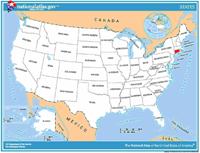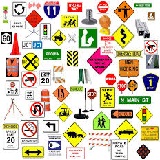Grammar:
Definition of a
manner adverb. |
- A manner adverb:
- answers the question, How?
- shows how the action of
a
verb is
done
- usually occurs at the end of the
sentence though sometimes they are placed before
the main
verb
-
Common irregular adverbs of manner not following the usual
adverb spelling rules include:
- high, late, near, well
-
Learn the
adverb spelling rules
|
|
Examples |
- She did the work carefully.
- She ate her food quickly.
- You can sing well.
- She sang that song badly.
- We watch them closely.
- She plays well.
- They walk carefully.
- The following words are manner adverbs
- agilely, badly, busily, carefully,
cheerfully, closely, completely, coyly, dramatically, dully,
duly, easily, fast, favorably, fully, gaily, greyly, happily,
hard, healthy, humbly, inadequately, little, loud, loudly, much,
normally, quickly, scientifically, shrilly, shyly, simply,
slowly, slyly, solely, specifically, straight, surprisingly,
truly, well, wholly
|
|
Fun Easy English Grammar Lessons |
|
|
Additional Lessons |
 About These
Lessons About These
Lessons
The following classroom lessons are great for students
who want additional listening and reading practice. |
-
Travel America -
Beginner
Level. Do you love America and American
English? Learn before you travel. Facts and other
cool stuff about your favorite U.S. state. Great
English reading practice.
|
 Travel
America - Connecticut Travel
America - Connecticut
(Beginner -
Reading)
Learn some interesting facts and read interesting
stories about Connecticut. |
 Connecticut Connecticut
One of the original 13 states, Connecticut is known
as the "Constitution State." It gets its name from
an Algonquian word meaning "land on the long tidal
river." Hartford has been the capital of Connecticut
since 1875 and the state flower is the mountain
laurel. |
Connecticut
State Flag
The state flag of Connecticut was inspired by a
memorial from a Connecticut chapter of the daughters of the
American Revolution. The flag design was already generally
accepted as the official flag of the state when it was
proposed for adoption in 1895 (the flag was formally
described in 1897 Connecticut legislation).
The flag includes a ribbon with the Connecticut state motto
on it: Qui transtulit sustinet (he who is transplanted still
sustains). The state seal of Connecticut also uses a similar
design featuring Connecticut's armorial bearings. |
|
Source:
State Symbols USA |
|
|
 Connecticut
State Facts Connecticut
State Facts
Picture: state seal of Connecticut |
|
State Capital |
Hartford |
|
Nickname |
Constitution State / Provision State / Nutmeg State |
|
Motto |
Qui transtulit sustinet (He who transplanted still
sustains) |
|
Statehood |
January 9, 1788 (5th) |
|
Origin of Name |
Based on the Mohegan word, Quinnehtukqut, meaning
"Long River Place" or "Beside the Long Tidal River" |
|
Largest Cities |
Bridgeport, Hartford, New Haven, Stamford, Waterbury |
|
Border States |
Massachusetts, New York, Rhode Island |
|
Area |
4,845 sq. mi.; 48th largest |
|
State Bird |
Robin |
|
State Flower |
Mountain laurel (kalmia latifolia) |
|
State Tree |
White Oak (quercus alba) |
|
State Song |
Yankee Doodle |
 Travel and tourism site
for Connecticut - This state travel and territorial
tourism site provides ideas for your vacations, meetings, and more. Travel and tourism site
for Connecticut - This state travel and territorial
tourism site provides ideas for your vacations, meetings, and more. |
|
|
Connecticut Stories |
|
|
Louis' Lunch
Do you love hamburgers? Do you know how they were created?
The first hamburgers in U.S. history were served in New Haven,
Connecticut, at Louis' Lunch sandwich shop in 1895. Louis Lassen,
founder of Louis' Lunch, ran a small lunch wagon selling steak
sandwiches to local factory workers. Because he didn't like to waste
the excess beef from his daily lunch rush, he ground it up, grilled
it, and served it between two slices of bread -- and America's first
hamburger was created.
The small Crown Street luncheonette is still owned and operated by
third and fourth generations of the Lassen family. Hamburgers are
still the specialty of the house, where steak is ground fresh each
day and hand molded, slow cooked, broiled vertically, and served
between two slices of toast with your choice of only three
"acceptable" garnishes: cheese, tomato, and onion.
Want ketchup or mustard? Forget it. You will be told "no" in no
uncertain terms. This is the home of the greatest hamburger in the
world, claim the owners, who are perhaps best known for allowing
their customers to have a burger the Lassen way or not at all. |
|
|
The Mark Twain House
Can a house have a heart and soul? Can people love their house even
if others think it's odd?
In 1871, writer Mark Twain moved to Hartford, Connecticut, to be
closer to his publisher. He rented a home in Nook Farm, a thriving
literary community at the western edge of Hartford. In 1873, Twain,
whose real name was Samuel Langhorne Clemens, and his family
purchased land on Farmington Avenue in Nook Farm and hired a New
York City architect to design a house.
As the house was being built, the local newspaper noted that "it is
one of the oddest looking buildings in the state ever designed for a
dwelling, if not in the whole country."
Twain once said that the house "had a heart, and a soul. ... It was
of us, and we were in its confidence and lived in its grace and in
the peace of its benediction. We never came from an absence that its
face did not light up and speak out its eloquent welcome -- and we
could not enter unmoved."
Twain lived and worked in the house from 1874 to 1891. During this
time he wrote The Adventures of Tom Sawyer, The Adventures of
Huckleberry Finn and A Connecticut Yankee in King Arthur's Court. Do
you think his unique house influenced his writing? |
|
|
Sisu and Creativity-The Essence of Finnish
Immigrants in Eastern Connecticut
Do you have sisu? Have you ever even heard of it before? Sisu is a
Finnish word that describes someone who works hard and has
determination and perseverance.
This word came to America with Finnish immigrants who began to
settle in Connecticut in the 1920s. The immigrants were escaping
poverty at home and looking for land, which they were able to buy
cheaply from Yankee farmers. Because they had sisu they became
successful in their new community.
Finnish sisu helped the immigrants farm rocky land and hand-pour
cement foundations for their homes and other buildings. Many made a
decent living selling chickens and eggs. Their hard work and
perseverance also helped them build social halls where immigrants
could meet others with similar backgrounds and languages. A group
called the Finnish American Education Association bought land and
built social halls in various parts of Connecticut.
In 1987, inspired by a desire to prevent the sale of their Finnish
hall for unpaid taxes, the Finnish American Heritage Society was
formed in Canterbury. To this day their mission is to promote
Finnish heritage, culture and language -- all of which they do with
a combination of hard work, determination, and perseverance.
The next time you have a very difficult job to do, think sisu! |
|
|
The Beckley Blast Furnace: East Canaan,
Connecticut
The furnace in the picture is a blast, literally. A blast furnace
increases combustion with a blast of air.
Blast furnaces contain a hearth at the bottom that is shaped like a
melting pot; a middle zone, called a bosh, a vertical shaft (the
stack) that extends from the bosh to the top of the furnace; and the
furnace top. The bosh is the hottest part of the furnace. Molten
iron gathers in the hearth, which has a tap hole to draw off the
molten iron and, higher up, a slag (residue) hole to remove the
mixture of impurities.
John Adam Beckley built this furnace in 1847 for the production of
pig iron, a crude kind of iron that is refined to produce steel or
wrought iron. In 1919, after 72 years of operation, the Beckley
Furnace closed.
In 1978, the Beckley Blast Furnace in East Canaan, Connecticut, was
put on the National Register of Historic Places. Connecticut bought
the furnace in 1946 with the intent of preserving the stack but
didn't restore it until 1999. The hearth has been completely rebuilt
with a cutaway section for visitor viewing. The blast furnace is a
significant attraction on the Iron Heritage Trail in Northwestern
Connecticut, New York, and Massachusetts. |
|
|
Monday Night Jazz Series and Greater Hartford
Festival of Jazz
If you were to go to Hartford, Connecticut, on a Monday night in the
summer, you could attend the oldest continually running jazz series
in the country. The kids you see in this photo are practicing, or in
jazz lingo, jamming, for the Monday Night Jazz Series.
As the sun goes down and the stars come out, you can listen to the
uniquely American musical form of jazz at the Monday Night Jazz
Series in Bushnell Park, in Hartford. This summer concert series
presents nationally and internationally renowned musicians as well
as local talent in celebration of all kinds of jazz music. Many
levels of performers -- from cutting-edge artists to youth from
local schools -- take part in the series.
Run by volunteers, the series has been held in Bushnell Park since
1966. The Greater Hartford Festival of Jazz, a weekend of free
performances, was initiated in 1991by the organizers of the Monday
Night Jazz Series, in honor of its 25th anniversary. |
|
|
Connecticut's State Song
How did a song help the Colonial soldiers win the Revolutionary War?
Connecticut's state song is "Yankee Doodle." This popular song has
an unusual history. The words were apparently written by an
Englishman during the French and Indian War in 1755. Originally, the
tune made fun of the poorly dressed and ill-equipped New England
soldiers. During the Revolutionary War with England, however,
Americans slightly rewrote the words to make fun of the British
soldiers. The song boosted the soldiers' morale (pronounced
"more-al"; it refers to a person's enthusiasm or mood) and was a
source of pride for the American soldiers. Good morale is important
during a war so that people don't get discouraged and give up.
Anything that could be done to boost morale was a good idea. |
|
|
Parade Spectacular
Have you ever seen a parade with floating balloons in the shape of
characters like Gumby or Dick Tracy? Do you know why such big
balloons float in the air? It's because they are filled with helium,
and helium gas is lighter than air so it floats.
Gumby, Dick Tracy, Rocky and Bullwinkle, and many other giant
balloon characters float through downtown Stamford, Connecticut, in
the annual Parade Spectacular. The festivities include marching
bands, dancers, and more. The parade falls at the same time as other
holiday events in town, from the lighting of the Christmas tree to a
North Pole adventure land in Latham Park.
Stamford's annual holiday balloon parade started in 1993 as a small,
hometown affair and has become one of the largest helium balloon
parades in the country, with 30 giant helium balloons floating above
the city and people coming from all over the region to see them. In
1999, there were an estimated 250,000 spectators. |
|
Source:
Library of Congress |
|
 Connecticut Connecticut
There are no national forests, parks, or
monuments in this state. |
|
|
|
 Travel
America Travel
America
Do you love America and American English? Learn before
you travel. Facts and other cool stuff about your
favorite U.S. state. Visit the Fun Easy English Travel
America pages. Read about the beautiful National
Forests, Parks, and Monuments. Great English reading practice. |
 Drive America Drive America
Planning to drive in America? Learn the rules and
regulations. Great English reading practice. |
|